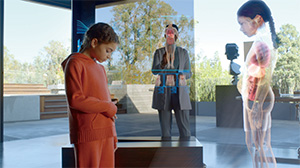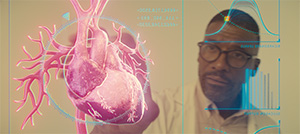 |
|
|
|
|
|
Feature Articles: NTT Research: Open Collaboration to Upgrade Reality Vol. 20, No. 1, pp. 20–22, Jan. 2022. https://doi.org/10.53829/ntr202201fa4 Bio Digital Twin Research UpdateAbstractThe mission of the Medical and Health Informatics Laboratories at NTT Research is to make advancements in the medical and health sciences that will improve an individual’s overall wellness and health outcomes. Our bio digital twin initiative aims to create digital replicas of patients that physicians can then use to simulate various treatments to enable optimal and patient-specific therapeutics. This article provides recent updates on our projects and team members. Keywords: bio digital twin, cardiovascular disease 1. IntroductionThe mission of the Medical and Health Informatics Laboratories at NTT Research is to make advancements in the medical and health sciences that will improve an individual’s overall wellness and health outcomes. Our bio digital twin initiative aims to create digital replicas of patients that physicians can then use to simulate various treatments to enable optimal and patient-specific therapeutics. In the initial phase of this project, we at the MEI Lab are developing a cardiovascular bio digital twin (CV BioDT). We are targeting the cardiovascular system in part because of that system’s prominent role in global mortality rates and the relatively high availability of data required for modeling. Over the past year, the MEI Lab has made significant progress on several fronts. In December 2020, we signed a research agreement with Japan’s National Cerebral and Cardiovascular Center (NCVC) to jointly develop cardiovascular disease-related computational models, implement them on a bio digital twin platform, and develop applications for use by physicians and patients. In the first half of 2021, we made two key hires, Dr. Jon Peterson, newly promoted to a distinguished scientist, and Iris Shelly as a scientist.
2. NCVC joint researchThe two-and-a-half-year project with the NCVC is titled “The Development of Human Hemodynamics Mapping and Autonomous Multimodal Therapeutics Systems.” It involves research at both organizations. The principal investigator (PI) for the joint research agreement on the NCVC side is Dr. Keita Saku, laboratory chief of NCVC’s Department of Cardiovascular Dynamics. I have the PI role on the NTT Research side. The agreement calls for the NCVC to develop integrated computational models to support multimodal closed-loop interventions for acute myocardial infarction (AMI) and acute heart failure (Acute HF). In parallel, the MEI Lab will be implementing these models into a bio digital twin platform and developing physician- and patient-oriented applications to support physician clinical decision making and patient self-care. The NCVC is a semi-independent national institution. Its government affiliation is through the Japan Ministry of Health, Labor and Welfare, the counterpart to the U.S. Department of Health and Human Services. The NCVC focuses on intramural cardiovascular clinical practice and dedicated cardiovascular research. As such, it resembles the National Heart, Lung and Blood Institute (NHLBI) of the U.S. National Institutes of Health. Unlike the NHLBI, however, the NCVC is not a cardiovascular research funding agency. Near-term goals for the joint project include the development and validation of models representing heart and vascular dynamics, particularly as they relate to AMI and Acute HF. Heart and vascular models that include neural control of circulation, as well as heart energetics, will be fundamental to computational platforms for determining optimal therapies for heart conditions. New models that Dr. Saku is developing in support of the CV BioDT will help determine optimal interventions for AMI and Acute HF across multiple therapeutic modalities such as medications, medical devices, and neuromodulation. The longer-term goal is to achieve patient-specific CV BioDTs to enable patient-specific therapeutics. The MEI Lab entered this partnership with Dr. Saku and the NCVC because of their internationally recognized expertise in cardiovascular regulation and advanced technologies relating to closed-loop automated therapeutic interventions for conditions such as heart failure and mechanical circulatory support. This exciting project has also benefited from the instrumental support of Dr. Kenji Sunagawa, professor emeritus in the Department of Cardiovascular Medicine at Kyushu University and founder of the Department of Cardiovascular Dynamics at the NCVC Research Institute. Dr. Sunagawa trained both Dr. Saku and myself (in my case, at Johns Hopkins University, Kyushu University and NCVC) and helped orchestrate this agreement. Going forward, he will play a leadership role in this project for the MEI Lab. By February 2021, the MEI Lab had already conducted two proof-of-concept studies to establish requirements and frame the initial bio digital twin platform architecture. The CV BioDT models developed through this joint research agreement will need to be validated in further studies before subsequent validation in preclinical human studies. These tests will be conducted at NCVC hospitals. During later stages of the CV BioDT validation and rollout, additional organ systems will be added towards the goal of an overall bio digital twin. In a noteworthy development, interfaces with the renal, respiratory, pulmonary and some neural systems are advancing sooner than expected.
3. New staff scientistsIn February 2021, it was announced that Dr. Jon Nels Peterson had joined the MEI Lab, then as a senior scientist. Dr. Peterson is a biomedical engineer with both academic and medical device industry experience. He had most recently been principal clinical systems engineer at Micro Systems Engineering, Inc., where he was the lead systems engineer for a family of implantable cardiac monitors. He also previously held research and engineering positions at Boston Scientific CRM and Creare, Inc. and was a research assistant professor at the University of Vermont College of Medicine. Dr. Peterson’s background as a research scientist and clinical systems engineer, with experience in hardware, firmware, and software subsystems, his talent for mathematical modeling and simulation, and his understanding of physiological control systems, as well as pathophysiological states such as heart failure, all bear directly on the MEI Lab’s agenda. In June 2021, it was announced that Iris Shelly had joined the MEI Lab as a scientist. An applied research engineer with expertise in biomedical signal processing and low-power devices, Shelly was most recently a senior applied research engineer at Micro Systems Engineering, Inc., where she designed, developed, and validated cardiac arrhythmia detection algorithms. She is initially working on model architecture and the interface for the CV BioDT. Her algorithm design experience and attention to detail, honed through years of experience in medical device research and software verification, are vital skills in support of model development for the CV BioDT. 4. Leadership shiftTaken together, the partnerships with the NCVC and new hires represent significant progress for the MEI Lab’s bio digital twin initiative, which I have led since joining NTT Research in 2020. Before closing, I should mention another notable development: my appointment as director of the MEI Lab in July 2021, where I succeeded Dr. Hitonobu Tomoike, who has assumed the position of research professor at the NTT Basic Research Lab. In this new position, I will continue to lead the CV BioDT group but now with Dr. Peterson as co-lead. I have also been engaged in harmonizing other MEI Lab projects, namely those involving implantable electrodes and remote sensing, within an overarching strategy that aligns with NTT Research and the broader NTT Group. It is an honor to follow in Dr. Tomoike’s footsteps and continue to advance the MEI Lab’s ambitious “moonshot” goals. |
|











